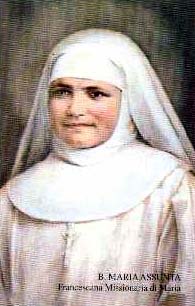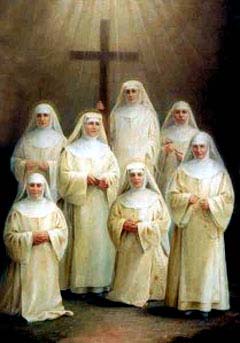인창동성당 게시판
|
4월7일(4월8일) 복녀 마리아 아순타 팔로따♬십자가 지고 가시는(Guitar) |
|---|
|
축일 4월7일(4월8일)
이탈리아 태생인 마리아는 마리아의 전교자 프란치스꼬회(Franciscan Missionaries of Mary) 수녀로서 중국에서 활동하다가 운명하였다.
▶ 복녀 아순타 팔로타 1904년 3월 19일 중국으로 파견된 마리아 아순따는 1905년 스물 여섯에 세상을 떠났습니다. 늘 모든 것에 만족하고 겸손하고 평온하였던 그녀는 모든 것에 앞서 하느님을 사랑하였습니다. 순수한 지향과 겸손이 널리 알려져 1954년 11월 7일 시복되었습니다. 이탈리아에서 아순타 마리아 리베르타(Assunta Maria Liberta)라는 이름으로 태어난 마리아 아순타 팔로타(Maria Assunta Pallotta)는 안코나(Ancona) 지방 마르케(Marche)의 카스텔로 디 크로체(Castello di Croce)에서 성장하였다. 그녀는 여섯 살 때 일찍 학교에 가서 읽고 쓰는 법을 배웠다. 그러나 더 이상의 교육을 받을 기회는 없었다.
마리아의 전교자 프란치스코 수녀회 소개 1877년 보편적 선교를 목표로 창립된 최초의 여자 수도회입니다. 74개 국적 7922명의 자매들이 76개국에서 언어, 문화와 생활 양식의 다양함 가운데서 하느님 나라의 일치를 증거하는 국제 공동체를 이루면서 하느님의 사랑을 전하기 위해서라면 모든 것을 떠나 파견된 그 어느 곳에든 갈 준비가 되어 있는 선교사들이지요.
마리아의 전교자 프란치스꼬회는 조건 없이 하느님의 뜻에 "예" 하셨던 마리아처럼, 성체를 관상하며 선교에 헌신할 힘을 얻는 마리아의 사도가 되어 겸손하고 가난하신 그리스도의 발자취를 따르신 프란치스코처럼, 단순함과 평화와 기쁨으로 세상 한 가운데서 복음을 생활하는 자매들의 공동체랍니다.
마리아의 전교자 프란치스꼬회 자매들의 정신은모든 민족, 모든 곳에 평화의 복음을 선포하신 프란치스코 성인의 자세를 따릅니다. 프란치스꼬처럼 우리도 우리 생활과 말로써 온 세상을 향하여 사랑이신 하느님께서 우리를 구원하셨다는 기쁜 소식을 선포합니다.
우리 생활의 중심은 성체입니다. 우리 전 존재의 뿌리는 하느님께 대한 관상에 있습니다. 하느님은 사람이 되시기까지, 자신의 생명을 바치기까지 인간을 사랑하시어 마침내 모든 이에게 부활의 희망을 주신 사랑이시며 삼위일체이신 분이십니다. 바로 이 사랑이 다른 이의 생명을 위하여 자신을 바치도록 우리를 재촉합니다.
단순함, 기쁨, 형제애, 가난한 이들에 대한 사랑, 전교적인 열정이 이 사랑에 대한 경탄에서 우러나옵니다. 우리는 다함께 공동체 안에서 생활합니다. 하느님은 공동체 안에서 참된 친교를 창조하시며 사랑의 일치를 체험하게 해 주십니다. 공동체 안의 친교와 사랑은 우리가 파견된 그곳 사람들에게 차고도 넘치어 하느님 사랑을 증거합니다.
▶ 일곱 명의 성녀들(축일:7월9일.게시판1871번) [FMM]성녀 마리 에르민느와 동료순교자들 ☞http://home.catholic.or.kr/gnbbs/ncbbs.dll/chinchang
마리아의 전교자 프란치스꼬 수녀회 수녀 일곱 명은 1859년 3월 12일 프랑스 마르세유를 떠나 5월 4일 중국 타이완 후에 도착했다. 그들은 세상 끝까지 평화의 복음을 선포하라는 그리스도의 부르심에 이끌려 중국이라는 완전히 낯설고 새로운 세상으로 자신을 내던졌다. 200명의 고아와 수많은 환자들이 생명을 가져다주는 여성의 손길을 기다리고 있었다.
▶ 마리아의 전교자 프란치스꼬 수녀회의 타이완 후 공동체 자신들의 세계와는 너무나 다른 세계와 문화 안에서 관계를 맺고 친교가 자라나기를 기다리는 것, 자신들에게 오는 많은 사람들의 필요 앞에서 느끼는 한계와 고통, 겸손과 창의력, 온유함과 강함으로 봉사하고, 계산하지 않고 내어주는 너그러움...그 공동체의 모든 생활 한 가운데에는 원천이요 반석인 그리스도가 계셨다. 마음을 뜨겁게 하는 말씀과 거행되고 조배 받으며 생활되는 성체로서. 공동체는 또한 그들이 생활하고 성장하고 쉬기 위한 장소요, 다시 다른 사람에게로 나아가기 위한 장소였다.
▶ 1900년 7월 9일 이 때 중국에는 폭력이 난무하고 있었다. 그 원인은 많고도 복합적이며, 때로는 모순되기도 하였다. 그 폭력은 특히 그리스도교 공동체와 선교사들을 향했다. 6월 27일, 상황이 극도로 긴장되었다. 수녀들을 피신시키려는 주교에게 마리 에르민느는 모두를 대신하여 이렇게 말하였다. "저희가 하느님의 사랑을 위하여 주교님들과 함께 죽는 것을 막지 말아주십시오. ... 저희는 이곳에 애덕을 행하려 왔고, 필요하다면 그리스도의 사랑을 위하여 피까지도 흘리러 왔습니다." 7월 9일 오후 4시경 군인들이 이들을 끌고 갔다. 학살이 시작되었다. 수녀들이 마지막으로 쓰러졌다. 그들은 서로 포옹하며 찬미의 노래인 떼데움을 부르면서 군인들에게 자신들의 머리를 내어놓았다.
▶ 그들은 누구인가? 마리 에르민느: 프랑스인, 34세. "우리 주변에 일어나는 모든 사건 안에서 하느님의 손길을 느낀다면 우리는 지치지 않고 그분께 감사드릴 것입니다." 마리 아망딘느: 벨기에인, 28세. "제가 가진 모든 것, 저의 생명, 마음, 활동, 저의 노래까지... 죽음이 저를 데려갈 때까지 예수님, 당신이 저를 차지하십시오" 마리아 끼아라 : 이탈리아인, 28세. "예수님, 당신께서 부르실 때, 저는 언제나 준비되어 있습니다." 마리 드 생뜨 나딸리: 프랑스인, 36세. "좋으신 주님, 저는 언제나 당신께 감사를 드려야 합니다." 마리 아돌핀느: 네덜란드인, 34세. "예수님께서 제가 주신 모은 은총, 특히 선교사의 소명에 충실할 수 있도록 저를 위하여 기도해 주십시오" 마리 드 생 쥐스트: 프랑스인, 34세. "나는 내 생명을 중국인들을 위하여 바치고 싶습니다." 마리 드 라 뻬 : 이탈리아인, 25세. "올해 주님은 제 안에서 신비로운 방법으로 일하십니다. 저는 그저 저를 위해 마련해두신 그 길로 인도되어 가도록 저 자신을 내어놓을 뿐입니다."
▶ 시성 2000년 10월 1일, 교황 요한 바오로 2세는 이들 일곱 여성들을 포함한 120명의 중국 순교자들을 성인으로 선포하였다. (마리아의 전교자 프란치스코수녀회홈에서)
♬십자가 지고 가시는(Guitar)-가톨릭성가123번
La Beata Maria Assunta Pallotta nacque a Force (AP) il 20 agosto 1878 da Luigi ed Eufrasia Casali, primogenita di cinque figli. A causa della povertà della famiglia non poté seguire un corso di studi regolare ed andò subito a lavorare. La sua vocazione alla vita religiosa arrivò in tenera età, il 4 maggio 1898 partì per il probandato delle suore Francescane Missionarie di Maria. Martirologio Romano: In località Dongerkou in Cina, beata Maria Assunta Pallotta, vergine delle Suore Francescane Missionarie di Maria, che, addetta ad umili servizi, visse nella semplicità e nel nascondimento per il regno di Cristo. La Beata Maria Asunta Pallotta, figlia di Luigi Pallotta e Eufrasia Casali, nata casualmente a Force il 20 agosto 1878, battezzata secondo la tradizione del tempo il giorno dopo (Assunta, Maria, Liberata), è stata cresimata 07.07.1880 da Mons. Bartolomeo Ortolani Vescovo e Principe di Ascoli Piceno nella Chiesa di s. Maria del popolo in Castel di Croce, qui anche è stato battezzato suo fratello Alessandro. Autore: Don Adam Baranski
Blessed Mary Assunta
Daughter of Luigi Pallotta and Eufrasia Casali. Baptized on 21 August 1878. She grew up in Castello di Croce, Marches of Ancona, Italy. Confirmed on 7 July 1880. In 1884 she briefly attended school, learning to read and write, but she received no further formal education. On 2 March 1897 she suddenly received an understanding of her call to religious life. Made her first vows with the Franciscan Missionaries of Mary in Rome, Italy on 5 May 1898. Moved to Florence, Italy on 3 January 1902. On 1 January 1904 she put in a request to go to China to work at a leper colony; her request was approved and she left Naples, Italy for China on 19 March 1904, arriving in Tong-Eul-Keou on 18 June 1904. She served several months as a cook in the orphanage there. In early April 1905 a wave of deadly typhus ran through the house. When one of her sisters appeared about to die, Sister Mary Assunta asked that she be taken instead; her prayer was granted. Born Died Venerated Beatified Canonized Book of Saints, by the Monks of Ramsgate “Blessed Mary Assunta”. Saints.SQPN.com. 7 April 2010. Web. {today’s date}.
April 8 Maria Assunta Pallotta was born in Italy in 1878, during the octave of the Assumption. The oldest of five children, she was always calm, gentle, peaceful, never seen to have fits of anger or caprice, never disobedient. Her parish priest would say later: “Every Sunday afternoon, when the church was deserted, we would find little Assunta kneeling there, praying”; then she would go to the catechism lessons and help him to instruct the youngest little ones. Frequent visits to the Blessed Sacrament marked all the years of her youth. At the age of fifteen she already had the maturity of an adult, being very serious and hard-working; she was wearing a hair shirt often, and fasting three times a week, even sleeping on stones. To answer the call of the Lord which she heard while still young, she perhaps would not have been able to free herself from the many duties involved in the life of a poor family, had not a kind prelate, when he visited her village, taken her cause in hand. He obtained her admission without a dowry to the Franciscan Missionaries of Mary, whose mother house was in Rome. She was twenty years old at that time. Always smiling and cheerful, she became a subject of edification for all. She scarcely knew how to read and write and was assigned to very humble tasks: with love she cared for the animals and did the laundry. Ever more humble, she would often go to ask for permission to do supplementary penances “to expiate her sins”, which permission was ordinarily refused. But she would return again to ask, and she made a vow to do everything for love of God, consecrating herself to His Sacred Heart. One day in 1904 she requested of her Mother General to remember her when there would be a mission to the lepers, to whom her institute devoted itself. She was sent to China in that same year, to the mission where seven of her Sisters had already shed their blood for Christ four years before. Her beautiful resolutions prove her sanctity: “I came to the convent to become a Saint: to what purpose would I live a long time if I did not attain my goal? I will therefore not pass up anything profitable for my soul, though the whole world be given me in exchange.” “Never will I excuse myself, never speak of myself, imitating the Most Blessed Virgin in humility and charity toward God and neighbor.” Soon the cross re-appeared in the peaceful halls of the orphanage, in the form of a typhus epidemic; and in March of 1905 three of the six newly-arrived Sisters were ill. Two departed for their heavenly reward, including the youngest of them all, and Sister Mary Assunta was the third to fall ill. She immediately asked for the Last Sacraments, saying she would die in a few days. Her condition afterwards seemed to improve, but after a week of severe sufferings, she too expired in peace. An odor of flowers was noted shortly before her death; it soon filled the room and the entire house. The Sisters were impressed, and when her body was exhumed in 1913 it was found virtually intact, though the robe was disintegrating. Miracles followed, and Mary Assunta was beatified by Pope Pius XII in November, 1954.
|





